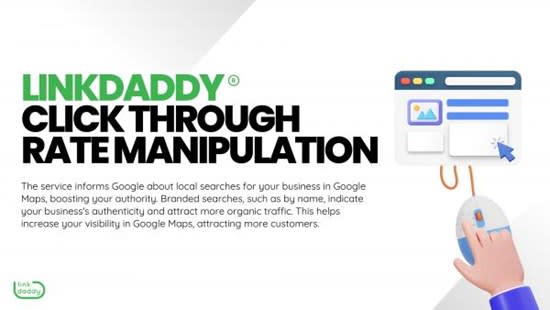LinkDaddy CTR Manipulation-- Professional Help for Boosting Your Web site's CTR
LinkDaddy CTR Manipulation-- Professional Help for Boosting Your Web site's CTR
Blog Article
CTR Manipulation: A Game Changer for Digital Campaigns
The rise of CTR adjustment has undoubtedly changed digital advertising and marketing methods, supplying marketing professionals with tools to boost engagement and drive website traffic efficiently. What effects might this stabilizing act hold for the future of digital projects?
Comprehending CTR Adjustment
Although click-through rate (CTR) adjustment may look like an uncomplicated technique in digital advertising, it includes a variety of methods focused on unnaturally inflating interaction metrics. This control can take various types, consisting of using click ranches, bots, or misleading ad placements that mislead consumers into clicking. These approaches can jeopardize the stability of performance data, making it challenging for marketers to evaluate the authentic effectiveness of their campaigns.
Additionally, CTR adjustment raises ethical worries, as it threatens the openness of electronic advertising and marketing. The dependence on filled with air metrics can lead to misguided advertising choices, skewing source allowance and project approaches. Companies might spend heavily in channels and strategies that appear successful but do not yield actual interaction or conversions.

Benefits of Click-Through Rate Optimization
Enhancing click-through rate (CTR) is important for improving the efficiency of electronic advertising and marketing projects. A greater CTR indicates that a larger proportion of individuals are engaging with the web content, which can result in enhanced site traffic and far better conversion prices. By enhancing CTR, brands can properly designate their advertising and marketing resources to initiatives that yield the highest possible returns.
One of the primary benefits of CTR optimization is the possibility for improved advertisement placement and reduced expenses - CTR Manipulation. Platforms like Google Advertisements award greater CTRs with better advertisement positioning and decreased cost-per-click (CPC), permitting marketers to extend their budgets additionally. In addition, a well-optimized CTR can improve brand name visibility, as greater engagement prices typically associate with increased organic reach

Strategies for Reliable CTR Control
To effectively manipulate click-through prices (CTR), marketing experts can utilize a variety of tactical strategies that boost individual interaction and drive web traffic. One basic approach is optimizing ad duplicate to produce compelling and action-oriented language. CTR Manipulation. Making use of strong call-to-action (CTA) expressions encourages individuals to take instant activity, increasing the possibility of clicks
Another reliable strategy more info here is A/B testing, see which enables marketing professionals to compare various ad variants. By methodically assessing efficiency metrics, they can determine which components resonate ideal with the target audience, therefore fine-tuning their methods for optimal impact. Furthermore, leveraging aesthetically attractive graphics and concise messaging can catch attention quickly, making it a lot more possible that customers will engage.

Finally, maximizing landing web pages to make certain a seamless individual experience can minimize bounce rates and encourage additional communication, inevitably cultivating greater CTR. By incorporating these methods, marketing experts can effectively manipulate CTR to accomplish their campaign objectives.
Measuring Success in Digital Campaigns
Determining success in digital campaigns calls for a clear understanding of vital efficiency signs (KPIs) that align with project goals. KPIs function as quantifiable metrics that help assess the performance of various strategies used throughout the campaign. Usual KPIs consist of click-through rates (CTR), conversion rates, price per purchase (CPA), and roi (ROI)
To efficiently gauge success, it is vital to establish details, quantifiable goals initially of the project. If the key objective is to raise brand understanding, metrics such as perceptions and engagement rates might be focused on. In contrast, projects focused on straight sales would take advantage of a more thorough analysis of conversion go to the website rates and earnings produced.
Routine evaluation of these KPIs makes it possible for marketing professionals to make data-driven choices, maximizing their methods in real-time. Making use of analytical tools can help in monitoring performance and recognizing trends, enabling quick changes to enhance campaign end results. Ultimately, a thorough approach to measuring success not just highlights areas for enhancement however also strengthens the general performance of digital advertising initiatives, driving continual development and engagement in the long-term.
Future Patterns in Digital Advertising
Expecting the future of digital advertising and marketing reveals a landscape shaped by fast technical developments and altering customer actions. As expert system and artificial intelligence remain to advance, online marketers will progressively take advantage of these modern technologies to individualize projects at an extraordinary range. Anticipating analytics will certainly make it possible for brands to anticipate customer needs, enhancing advertisement placements and content delivery in real time.
Moreover, the rise of voice search and smart tools is changing exactly how customers communicate with digital material. Online marketers will need to adjust their approaches to make sure exposure across several platforms, consisting of voice-activated aides. This change demands a concentrate on conversational advertising, highlighting engagement with dialogue as opposed to typical promotional methods.
Furthermore, privacy concerns are prompting adjustments in information collection practices. Openness and honest data use will become extremely important, driving brands to foster depend on and loyalty amongst consumers. The ongoing development of social media systems will certainly additionally influence advertising and marketing methods, with an increased focus on authenticity and user-generated web content.
Final Thought
In summary, CTR adjustment represents a significant innovation in electronic advertising and marketing methods, using prompt advantages through boosted engagement metrics. Nevertheless, the ethical factors to consider surrounding such methods demand a mindful strategy to ensure long-term brand name integrity and genuine audience connection. By striking a balance between optimization techniques and genuine involvement, marketers can grow lasting partnerships with customers. The continuous evolution of digital marketing will rely on this fragile interplay, forming the future landscape of brand-consumer interactions.
Report this page